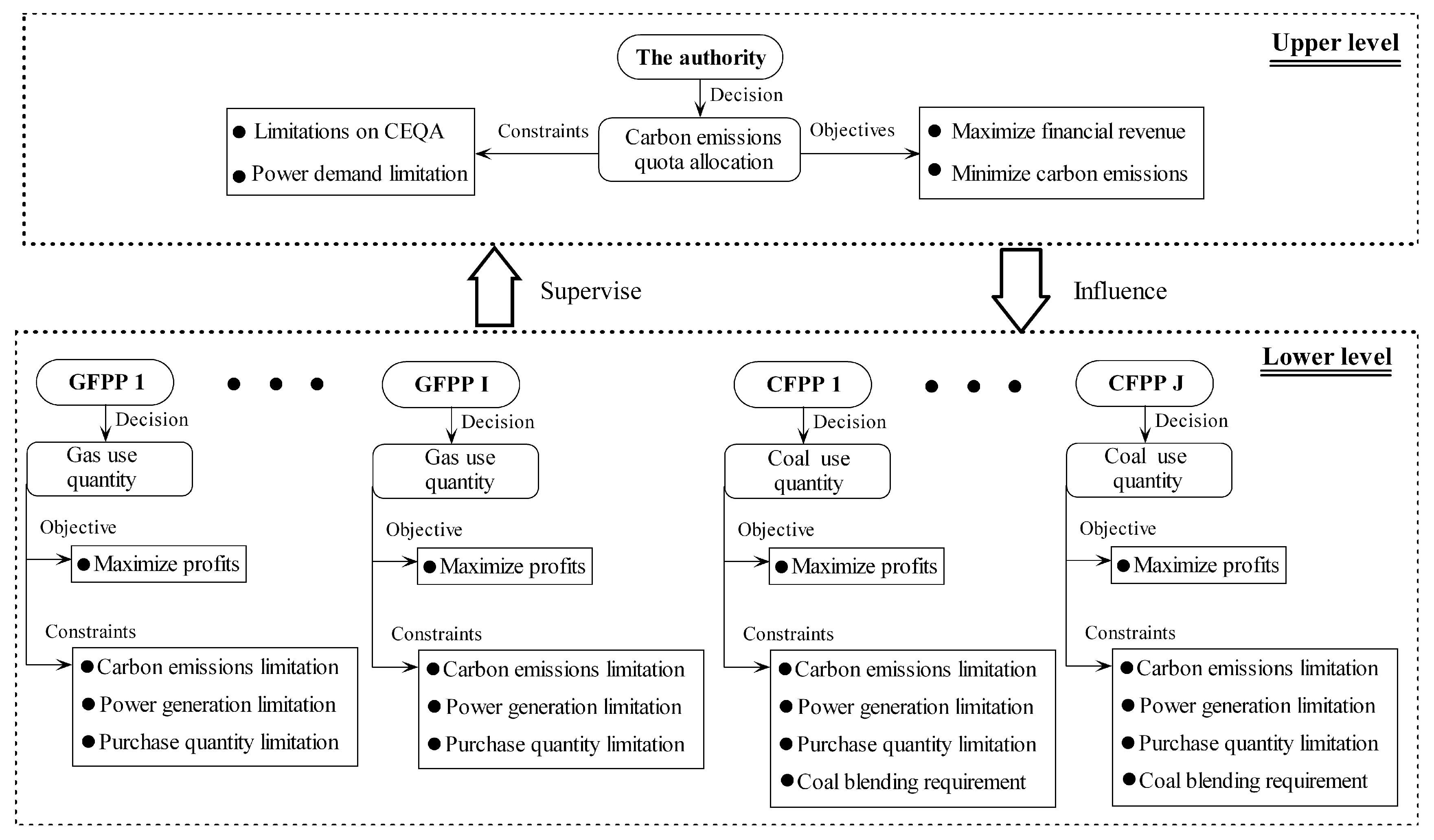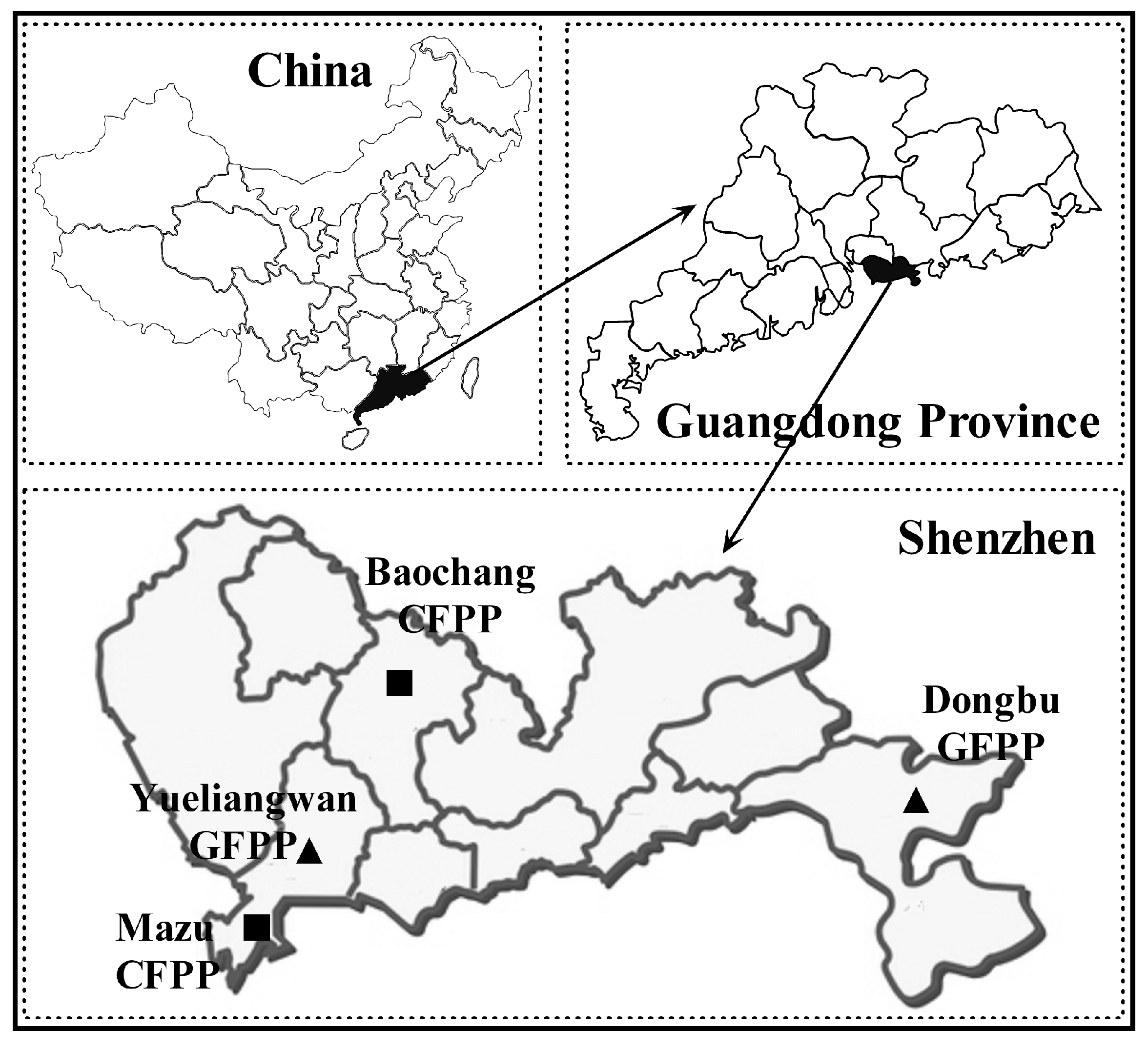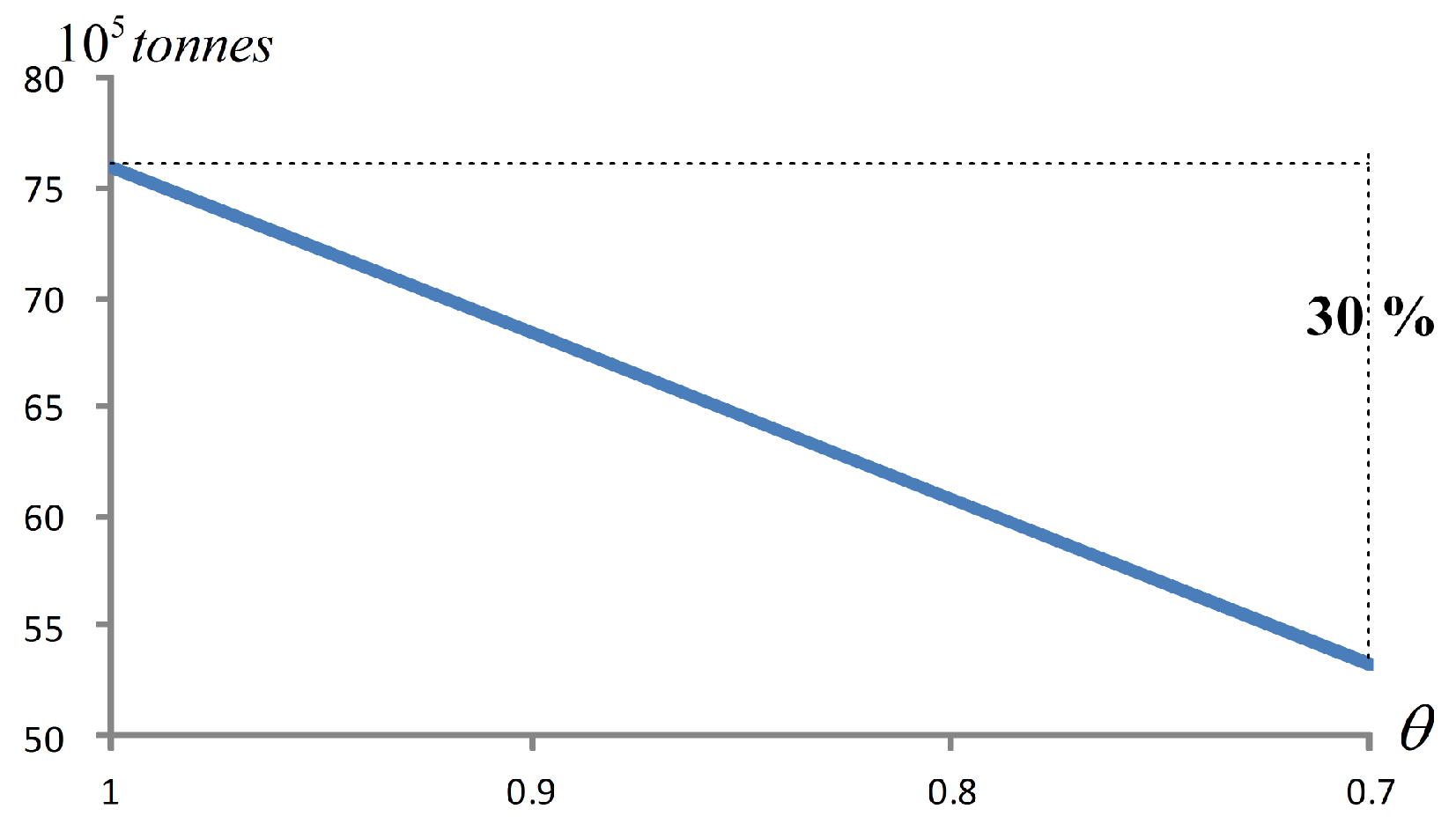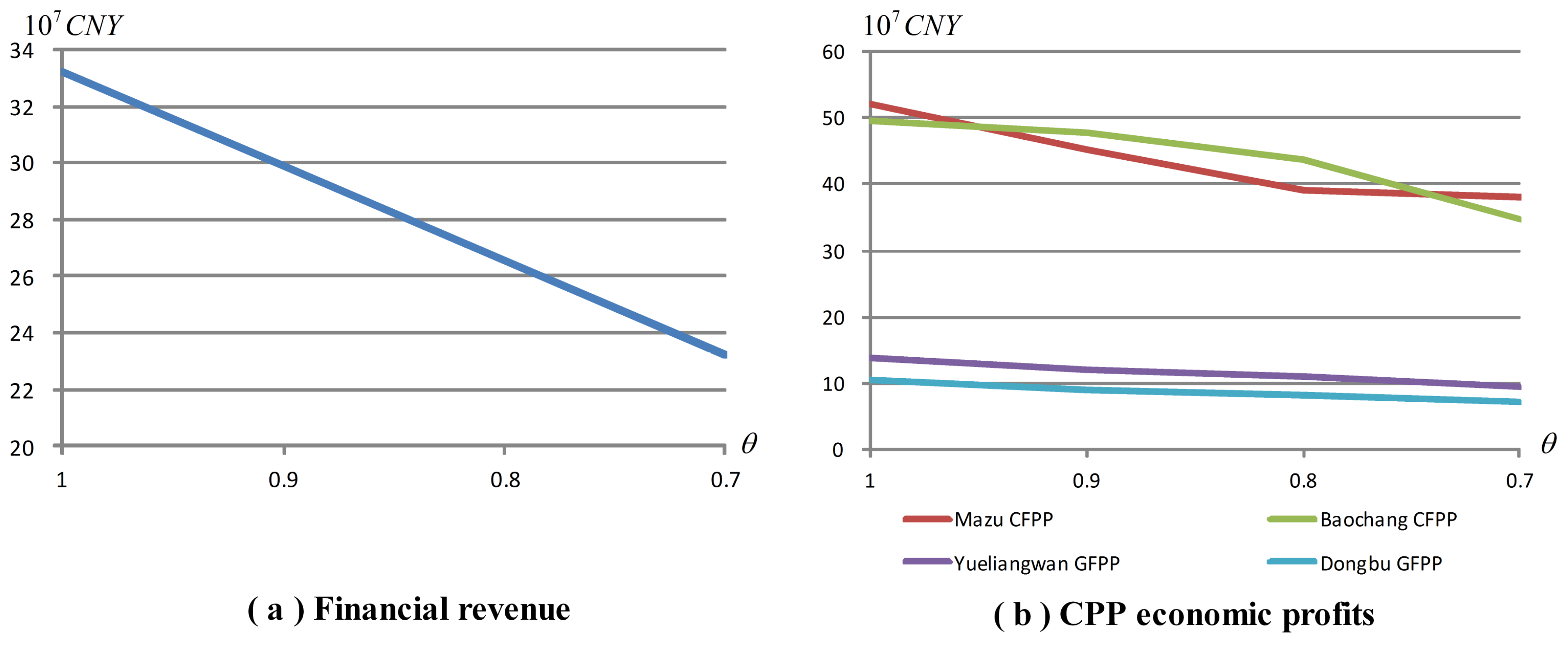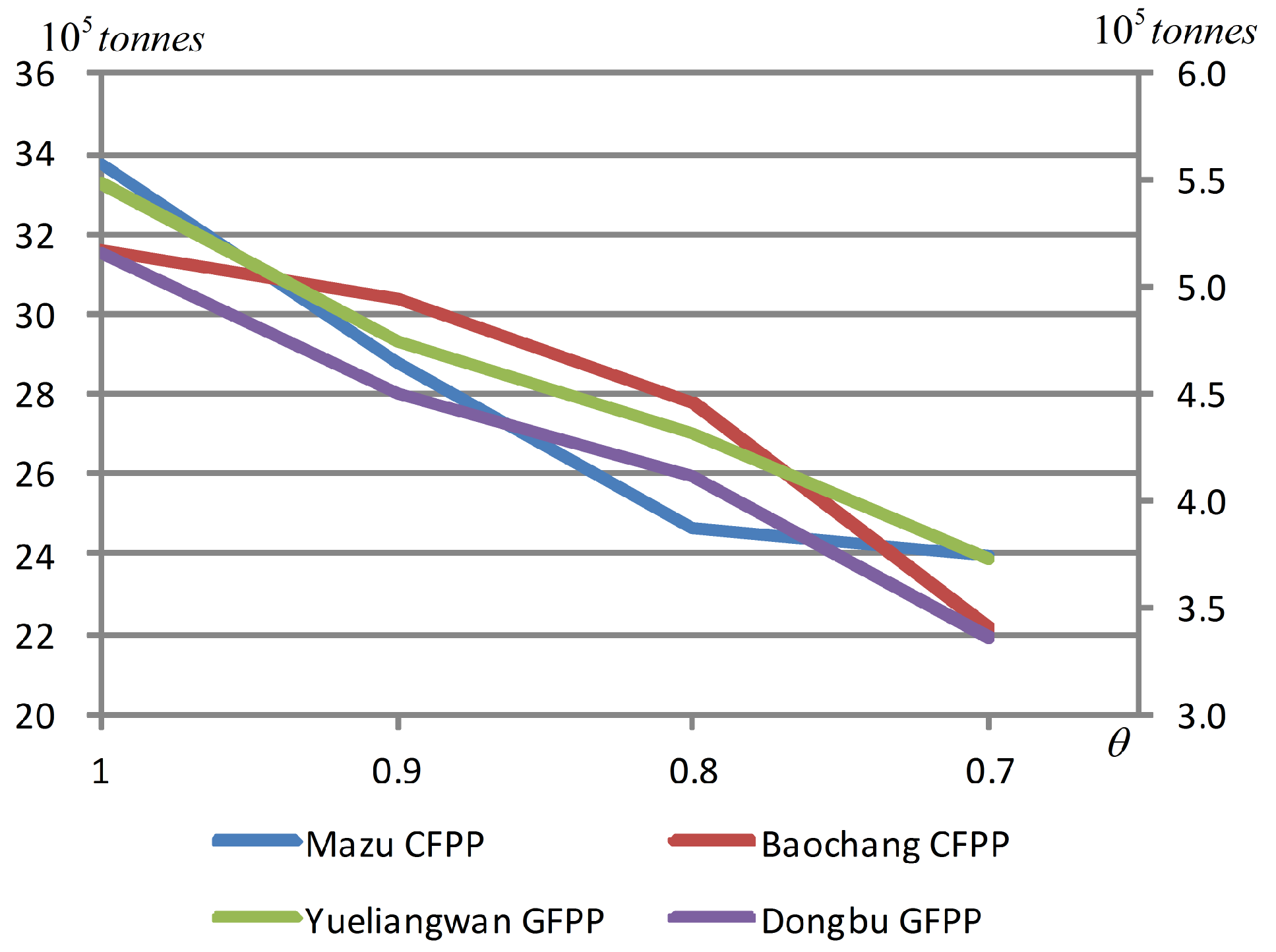1. Introduction
With the development of economy and urbanization, power consumption grows strongly. It was stated by BP Energy Outlook that that almost 70% of the increase in primary energy was used for power generation, with power demand growing three times more quickly than other energy [
1]. According to BP Statistical Review of World Energy, electricity generation has increased from 20,046 TWh to 25,551 TWh in the past ten years, 38.1% and 23.2% of which were respectively generated by coal and gas [
2]. Conventional coal fired power plants (CFPP) or gas fired power plants (GFPP) are still the predominant electricity generators and will be for decades to come around the world [
3]. However, as two-thirds of the world’s electricity is generated by conventional power plants (CPP), the amount of carbon emissions is up to 33,444 million tonnes just in 2018 [
2,
4]. Carbon dioxide is an important greenhouse gas which resulted in global warming and sea level rise [
5]. As it would take a long time to generate electricity mainly from renewable energy sources, addressing vast carbon emissions from CFPPs or GFPPs is extremely urgent [
6].
Some research regarding reducing carbon emissions from CPPs proposed technical reduction measures or structure-adjustment reduction measures. Mao et al. enumerated carbon emission reduction measures in the power industry; for example, coal washing, carbon capture and storage/sequestration, substituting large-sized units for small-sized ones, circulating fluidized bed power generation technology, etc. [
6]. Fisher et al. used direct oxygen input to burn the carbon-based fuel in a nitrogen deficient atmosphere created by flue gas recirculation and achieved the aim of less carbon emissions and a near elimination of nitrogen oxides in the flue exhaust [
7]. Amitava et al. reported on an effective chemical solvent scrubbing method to remove carbon dioxide from the flue gases emitted from the power plants, which can minimize energy requirements, equipment size as well as corrosion [
8]. Although these methods can effectively reduce carbon emissions, they are expensive and not suitable to implement at a large scale.
Policy schemes, such as command and control, carbon tax and emissions trading (ET) have been adopted to reduce carbon emissions in CPPs. Holbert et al. analyzed the use of satellite-based methods which included the global positioning system and low earth orbit satellites for the command and control of power systems, and proposed a multiagent supervisory-level power system stabilizer as a potential wide-area control structure [
9]. Olsen et al. proposed bi-level method and weighted sum bisection method to determine the lowest emission tax rate that can reduce the anticipated emissions of the power sector below a prescribed, regulatory-defined target, and concluded that carbon tax increased the value proposition for investment in new cleaner generation, transmission, and energy efficiency [
10]. Cong et al. studied the impact of introduction of ET on China’s power sector in a computable framework using an agent-based model and found that ET can provide China government and related decision-makers a quantity tool for designing carbon market [
11]. Carbon tax is an immediate carbon price signal. However, the total carbon reduction is hard to control, and the rational tax rates are hard to determine [
12]. Of these policy schemes, ET is a more suitable option as it is political feasibility and cost effectiveness that can provide economic incentives to meet the policy targets [
13,
14].
The researches of ET have always focused on carbon emissions quota allocation(CEQA). Ma et al. developed a bi-level programming model to optimally allocate carbon emission quotas to the corporations based on both fairness and efficiency principles, and then employed a zero sum gains data envelopment analysis model to evaluate the efficiency of the allocation [
15]. Li et al. set the mixed quota allocation method which was most proper for all 30 provinces in China and considered survival and development, and indicated the proposed method could make 76% of province be in the status of normal operation [
16]. Kim et al. assessed the impact of quotas and carbon prices on pulverised coal power plant and gas-fired power plant in the UK using long-term dispatch model and the integrated planning model, and draw some conclusions about the nature of over-compensation of freely distributed quotas [
17]. Although these researches have provided some valuable insights, the realistic is more complex and further research is needed.
In CEQA problem, there always exists contradiction between the authority and CPPs due to different objectives. The authority allocates carbon emissions quota to every CPP based on its objectives of economic development and environmental protection. Under the carbon emissions quota, CFPPs and GFPPs makes its generation planning to pursue the largest economic profits. Equilibrium strategy has proved to be a powerful tool to deal with this problem. Zhang et al. designed a Pigovian tax-based equilibrium strategy for waste-load allocation for water quality management that fully considers the Stackelberg game between the environmental regulators and the river system dischargers [
18]. Hassin et al. presented a equilibrium strategy model of parallel queues in front of two servers that provided the same service, and found cascade equilibrium strategies evened when the servers were identical with respect to service rate or inspection cost [
19]. These researches have inspired the application of an equilibrium strategy method in CEQA problem to tackle the conflict between the authority and CPPs for carbon emissions reduction to ensure sustainable development. As equilibrium strategy is an abstract theory, bi-level programming method is used to accurately represent equilibrium strategy [
20].
However, there are still two barriers have to be overcome when adopting equilibrium strategy in CEQA problem. First, the trade-off between economic development and environmental protection needs to be fully considered. Protecting the environment during promotion economic development is the requirement of sustainable development. Therefore, multi-objective programming method is employed to balance the trade-off between economy and environment. The second barrier is that the uncertainties in the decision making system are inherent. For instance, carbon emissions factor are difficult to measure exactly to unstable combustion environment. Therefore, uncertainty theory is applied in CEQA problem.
From the discussions above, for the purpose of carbon emissions reduction to ensure sustainable development, an equilibrium strategy-based bi-level multi-objective programming method under an uncertain environment is proposed to build the cooperative relationship between the authority and CPPs and balance the trade-off between economic development and environmental protection. The remainder of this paper is organized as follows. In the next section, details of the key problems are explained in preparation for the establishment of the mathematical model, the mathematical form for which is given in
Section 3. In
Section 4, a real world case study is then presented to demonstrate the effectiveness of the proposed model and solution approach. Then, in
Section 5 the model results are analyzed and comprehensive discussions and policy implications provided. Conclusions and future research possibilities are given in the final section.
2. Key Problem Statement
To develop an equilibrium strategy-based bi-level multi-objective programming method to reduce carbon emissions, some background and descriptions are given.
There are several decision makers involved in carbon emissions: the authority and CPPs. In the decision making system, the authority has the ability to make decisions first due to its higher position. Considering its own objectives, the authority makes an initial decision on CEQA and allocates carbon emissions to every CPP. Under the limited carbon emissions quota, CFPPs and GFPPs make their decisions on fuel use quantity and then give feedback to the authority. After the authority receives feedback from various CPPs, it has to reconsider the initial CEQA, makes an updated decision on CEQA and forwards the new scheme to the CPPs. The CFPPs and GFPPs again decide on fuel use quantity based on the new carbon emissions quota and feed back to the authority. From this interactive process, the authority finally decides on an optimal strategy under a termination condition, and the CPPs develop their own optimal coping strategy. As a result, the authority and CPPs finally reach an equilibrium that indicates the global satisfactory solution for the CEQA problem. During the process, the conflicts and cooperation coexist between the authority and CPPs. Therefore, a Stackelberg game is shaped; the authority plays the part of a leader while the CPPs act as the followers [
21]. Bi-level programming, a hierarchal decision making structure, has the ability to describe Stackelberg game of different decision makers [
22,
23,
24].
As rather serious environmental problems incurred in CFPPs and GFPPs, the element of environmental protection should be given due consideration and incorporated into CEQA problem. How to coordinate the relation between economic development and environmental protection has been an attraction [
25,
26]. In CEQA problem, the trade-off between economic development and environmental protection is difficult for the authority to balance. In this paper, financial revenue represents economic development as a result of with it the authority can ensure stable development for a long term, while carbon emissions represents environmental development since the amount of carbon emissions is one of important indicators to comprehensively assess the status of sustainable development. Therefore, multi-objective programming is adopted to assist the authority in making an optimal decision on CEQA for a harmonious development of economy and environment. From the perspective from CPPs, under the limited CEQA, reasonable arrangement of generation is necessary. With regard to GFPPs, they make an optimal strategy concerning fuel use quantity within some limitations in order to pursue largest economic profits. However, as for CFPPs, the situation is more complex and coal blending is usually their option. Coal blending which involves the blending of several kinds of coal to ensure the volatile matter content, heat rate, ash content, moisture content and sulfur content satisfy power generation utility requirements, is a cost-effective method [
27]. Dai et al. established a simulation-based fuzzy possibilistic programming model which fully considered uncertainty reflection, pollutant dispersion modeling, and the management of coal blending and the related human health risks [
28]. Shih et al. developed a multi-objective chance-constrained optimization model which involved uncertainty and variability in coal properties, and the effect of off-design coal characteristics on power plant performance and cost [
29]. Therefore, coal blending method is employed in CFPPs for purpose of achieving maximum profit under limited CEQA.
As discussed above, the complicated decision-making relationship between the authority and CPPs for CEQA problem is shown graphically in
Figure 1. The mathematical form for this equilibrium strategy-based bi-level multi-objective programming method is given in the next section.
6. Conclusions and Future Study
To achieve carbon emissions reduction in CPPs, this paper proposed an equilibrium strategy-based bi-level multi-objective programming method under an uncertain environment which fully considered the conflict between the authority and CPPs, the trade-off between environmental protection and economic development. By using the proposed model, rational carbon emissions quota allocation mechanism is established. In this mechanism, the authority allocated a certain amount of carbon emissions quota to the CFPPs or GFPPs. Under the limited carbon emissions quota, each CFPP and each GFPP developed its own generation plans strategies. The proposed method was applied in a real case of Shenzhen to demonstrate its efficiency and practicability and adopted Matlab to calculate the results. Based on the results, some conclusions were reached. First, the CEQA-based equilibrium strategy effectively reduced carbon emissions. Then, stricter carbon emissions reductions targets lead to a large fall in both revenue and profits. Moreover, GFPPs had an advantage over CFPPs in CEQA.
In this paper, we mainly considered two stakeholders in the decision making system. In the future, more stakeholders, such as non-profit environmental organizations, would be considered. In this paper, we only considered carbon emissions reduction and some pollutants, such as , were ignored. In the future, a more comprehensive methodology for improving regional atmospheric environments would be developed.
